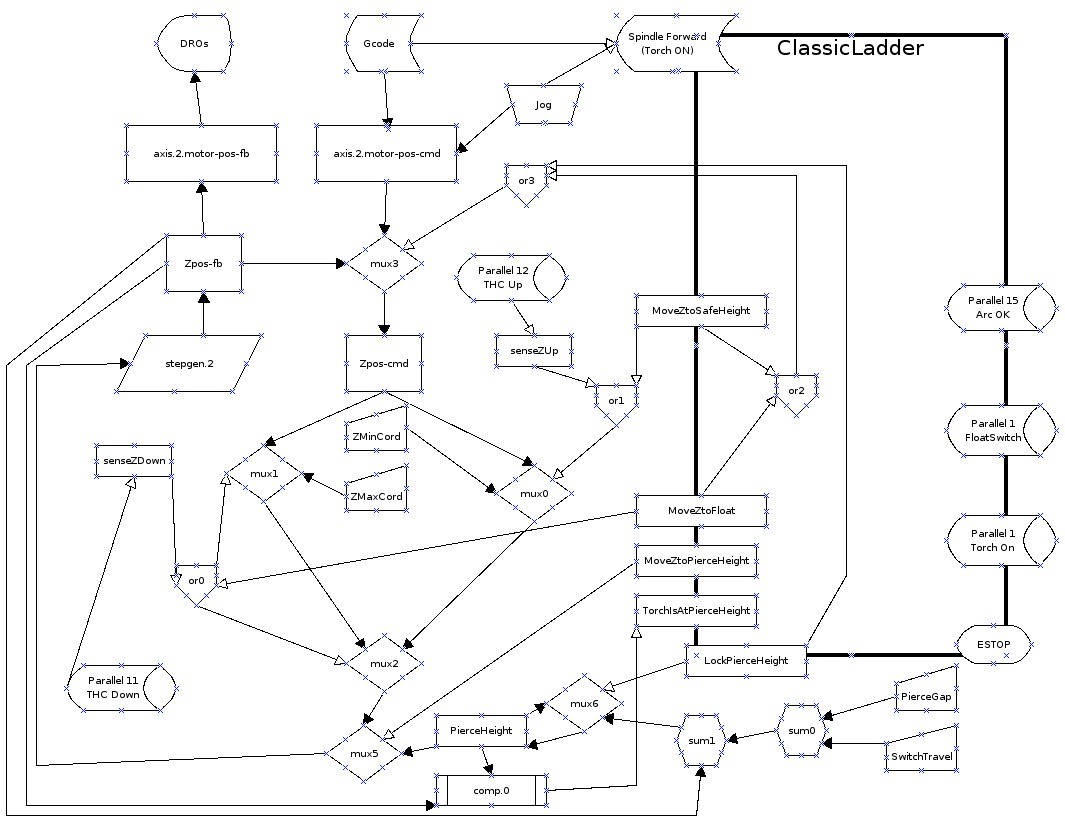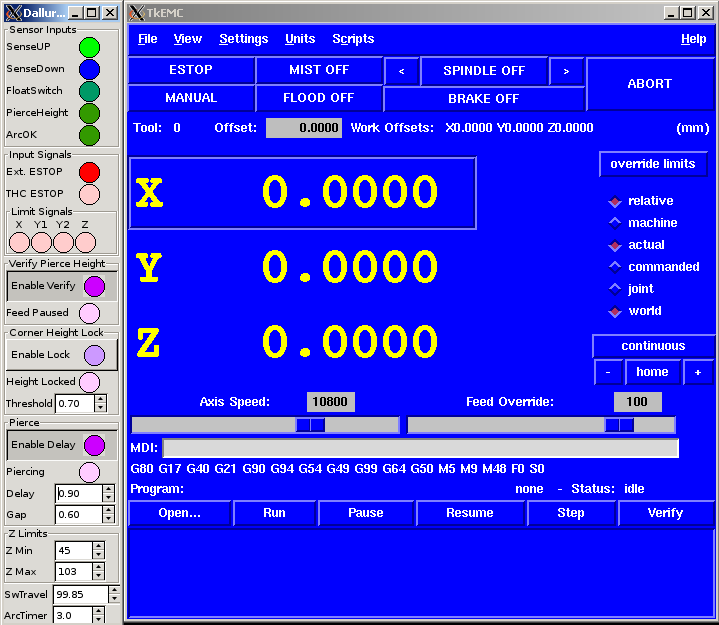ATTENTION!
There is a more recent plasma sample config shipping with EMC, the new config is called plasma-thc while the old config is called dallur-thc.
The new config uses HAL components instead of ClassicLadder logic, it also features a much more advanced control panel, noise filtering and support for serial interface.
The configs can be browsed in the EMC git repository: [configs/dallur-thc/] [configs/plasma-thc/]
There is also a third simulator config, the simulator config has virtual input signals for testing: [configs/plasma-thc-sim/]
The new config includes different variants for all THC systems by Bob Campbell and CandCNC?: [configs/plasma-thc/thc300.odg] [configs/plasma-thc/mp1000A.odg] [configs/plasma-thc/mp10000B.odg]
See also the [configs/plasma-thc/README]
Here is a screenshot of the plasma-thc UI with all panels

This page is intended to help EMC users set up a Plasma Control system with Torch Height Control and Charge Pump (15khz). At this time this config is still experimental so please be careful and feel free to report any issues to Rugludallur on IRC or rugludallur@rugludallur.com. The attached configs were made with a THC300 from Bob Campbell but is based mostly on documentation from CandCNC and should work just fine on the THC1000 from CandCNC. CandCNC also offers the possibility of controlling the voltage settings from software and it might be worth adding that functionality to the configuration. The configs assume that Parallel Port 1 is connected to a breakout/combo board from Bob Cambell but Parallel Port 2 to the THC300/THC1000. Note that this configuration has 4 axis configured, X,Y,Z,A where A is the second motor on the Y axis and is slaved to the Y axis. The configuration assumes that Z axis is homed to TOP as is tradition with Z axis and that a Torch Float switch is connected via the THC300, please note that the Float switch should not be confused/joined with the Z axis home/limit switch. It is highly recommended to have an inductive or capacative NPN or PNP float switch.Here is a list of the parallel pins that are used:
Pin 08 - Dir signal for Z axis
Pin 09 - Dir signal for A axis (reversed from Pin 7)
Pin 10 - External Estop
Pin 11 - Limit/home switch for X axis
Pin 12 - Limit/home switch for Y axis
Pin 13 - Limit/home switch for Z axis
Pin 15 - Limit/home Switch for A axis
Pin 17 - Charge Pump 15Khz out
Port2:
Pin 01 - Spindle ON (Torch ON)
Pin 11 - Move Z axis DOWN
Pin 12 - Move Z axis UP
Pin 15 - Arc OK signal
Pin 13 - Torch Float Switch (contact switch)
Pin 17 - Charge Pump 15Khz out
The logic is implemented in HAL and Classicladder, this Kivio document shows the HAL in a flowchart but the Classicladder should explain itself, provided are images of both and links to the original documents which you can update with any changes.


upload:Dallur_thc_design.flw

Here are the configuration files, these are still experimental.
upload:dallur-classicladder.hal
upload:dallur-advanced.ini
upload:dallur-core_stepper.hal
upload:dallur-advanced.clp
upload:dallur-advanced.hal
upload:dallur-advanced.vcp
upload:dallur-halvcp.hal
Here is the sofware design document:
upload:dallur-thc-design.txt
For more info on the modules used see:
HALUI halui
HALVCP M5i20 Halvcp Test Panel
EMC2 ClassicLadder
Original Classicladder http://membres.lycos.fr/mavati/classicladder/
New Plasma Design http://dallur.com/fileadmin/user_upload/NewPlasmaDesign.odg